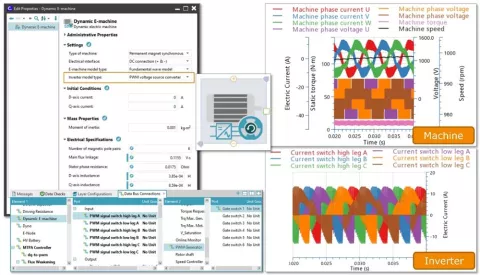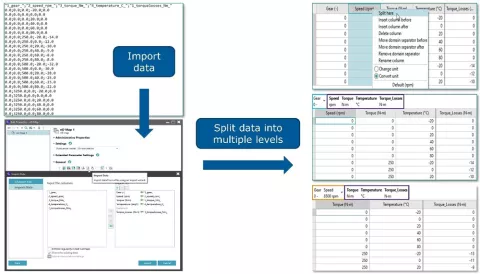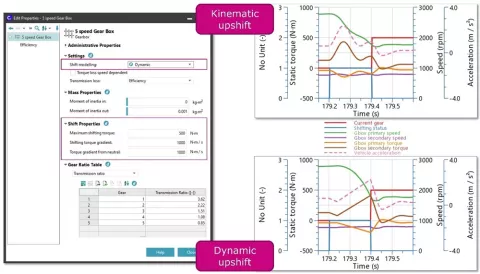
Don't miss the latest enhancements in the area of Virtual System Development.
The Dynamic E-Machine component has been extended to enable inverter behavior to be modelled. The inverter model type is described either as an average voltage source converter or as a pulse-width modulation (PWM) voltage source converter.
The PWM approach offers the advantage that the component can be controlled by PWM signals. In this case, the internal inverter allows the application of an e-machine model operating on three phases. The simulation results show three-phase details including switching current and voltage in the different branches of the inverter and in the corresponding branches of the e-machine.

Extension of the Powertrain Model Generator to provide automatically generated result pages.
The scope of the result pages depends on the powertrain configuration selected and the results include time resolved data and scalar KPIs. The standard reports facilitate the assessment of powertrain configurations by providing a focused summary for review.

When physical modeling reaches its limits or when comprehensive experimental data are available, an effective dealing with multidimensional data comes into the spotlight. To this end, CRUISE M introduces a new dedicated nD Map component.
Data is stored in tabular form and is individually configurable. You can divide the columns into any number of domains and co-domains, the former requires inputs and the latter the outputs of the data evaluations. Corresponding data bus input and output ports are created automatically. This allows maps (i.e. loss as function of speed and torque) to be placed under other maps (i.e. gear and temperature), thus dividing a higher dimensional data structure (i.e. 5D) into smaller entities. Data assessment is thus made much easier.


CRUISE M simulation results can be saved as ASCII files (i.e., CVS) and in binary format. Now another option has been added and results can also be saved in MAT file format.
Results saved as MAT files can naturally be used for standard post-processing in AVL IMPRESS™ M. In addition, they can be loaded into MATLAB®. The result data itself is delivered in a structured form. Global metadata and the list of components are on the top level. From there, you can drill down to the level of individual signals and perform any type of result analysis.
The propagation of heat through a 3D structure can be easily studied with the new functionality of the Discretized Solid 3D component.
On the new input page, you specify the layers where heat is to be released. Despite the simplicity of the input, you can accurately view the effect of a local temperature increase on neighboring zones. In addition, you can analyze the propagation of a temperature wave through the entire solid structure.


Dynamic switching models are often the better choice for (virtual) test bed applications.
A kinematic shifting model describes the shifting process exactly in time and requires sophisticated numerical treatment in the background. The dynamic shift model avoids exactly that. Therefore, we have now extended the Gear Box component and the existing kinematic-fixed shifting process with the possibility to describe the shifting process dynamically.